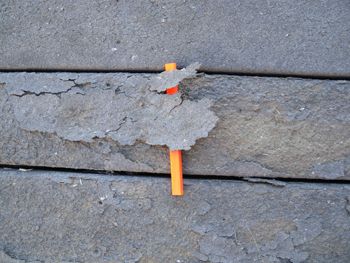First of all- let me start off by highlighting that I enjoy the look of smooth composite decking as much as the next person. I get excited about innovations in the decking industry and products that take the work out of maintaining a nice deck. Although- if it sounds too good to be true, it usually is. There’s no arguing that a demand exists for low-maintenance materials in outdoor structures. I DO think that the market shift to alternative materials is inevitable- although we clearly haven’t hit the point of perfection with these products.
History
When Trex first came out it was the “miracle material”- claiming to be “maintenance-free” and the public quickly found out that there were a few faults in the product itself. Between 1996 and 2004 there was a National Class Action Lawsuit against trex for “surface flaking” and was finally settled in October of 2009. In my opinion, everyone makes mistakes, composite is still a relatively new product and (like any product) it’s rarely perfect on the first try. Although when the company refuses to admit fault- that should make consumers run:
“Our decision to settle the case is not an admission of any of the allegations made by the plaintiffs but rather a way to avoid expensive and time-consuming litigation. Trex has steadfastly stood behind our warranty with respect to all affected product. Although we were fully prepared to defend this action and we strongly believe we would have prevailed, we were offered the opportunity to settle on terms that we feel are a win-win for both Trex and our consumers.”
Example of decking effects:
Trex settled to replace the full cost of decking and partial labour costs. Even after some home owners waited 13 years for a return- they didn’t even break even. Trex is currently a public company with a market cap of just under $380 million. Since Trex is a pubic company, the public is privy to their financial. From 2004-2009, the company had a Net Loss of just over $10 million with currently (2009) debts over $100 million. Yet the CEO seems optimistic enough to go on CNBC to talk about their new products. Trex has constantly been underperforming the S&P 600 Building Products Index and other indices representing new/existing building growth.
Trex started as the ‘Coca-Cola’ or ‘Xerox’ of composite decking products- after their failed PR it gave room for new entries to the ‘low-maintenance’ decking market. The brand Azek continues to grow in popularity and still holds a ‘relatively’ good name. Although for all we know- it could be another ‘Trex’, only time will tell. Wood has been around since the dawn of time, we know it’s imperfections and they’re manageable. Composite is still in it’s infancy- and we know very little of the long-term effects of these new products.
“Eco-Friendly” VS Deforestation?
Some composites claim to be ‘eco-friendly’ and use that as a selling point for the ever-growing ‘going green’ market. New sources of energy and saving the environment was a huge part of the last Presidential Debate and it’s been a growing market ever since. So let’s take a look at what kind of carbon footprint it takes to produce composite products. Since composite is made out of things like recycled plastic bags we have to take a look at how those bags were made- oil. A statistics class at Indiana U figured out that “more than 1.6 billion gallons of oil are used each year for plastic bags alone” and we recycle less than 1%. Although I’m not an advocate of tree deforestation- there are growing initiatives that promote the planting of trees. In fact, I remember going to a field trip in school and planted over 200 trees in one afternoon. The effects of oil on our environment are permanent, although we can always plant more trees. So now we know why Trex was actually bought by Mobil Oil (via leveraged buyout in 1996).
“Low-Maintenance” VS Annual Maintenance?
When composite decking first came out they claimed to be “maintenance-free”, although now they shy away from bulletproof  claims and use the term “low-maintenance”. The biggest issue with composite nowadays is the molding/mildew and the constant absorption of water: What you see in that picture is not just the mold resulting from water absorption. Trex made a ‘blend’ in which they combined two different products to make Trex Brasilia (2008). The result of this: oil being forced out of the product by the sun, creating black spots that are literally impossible to clean out of the wood. This deck was installed following the Trex installation instructions. As of mid 2008, Trex has replaced 37,000 faulty decks because of the products installed. They still continue to keep a healthy retainer aside pay for these replacements- even Trex doesn’t believe what they preach.
claims and use the term “low-maintenance”. The biggest issue with composite nowadays is the molding/mildew and the constant absorption of water: What you see in that picture is not just the mold resulting from water absorption. Trex made a ‘blend’ in which they combined two different products to make Trex Brasilia (2008). The result of this: oil being forced out of the product by the sun, creating black spots that are literally impossible to clean out of the wood. This deck was installed following the Trex installation instructions. As of mid 2008, Trex has replaced 37,000 faulty decks because of the products installed. They still continue to keep a healthy retainer aside pay for these replacements- even Trex doesn’t believe what they preach.
